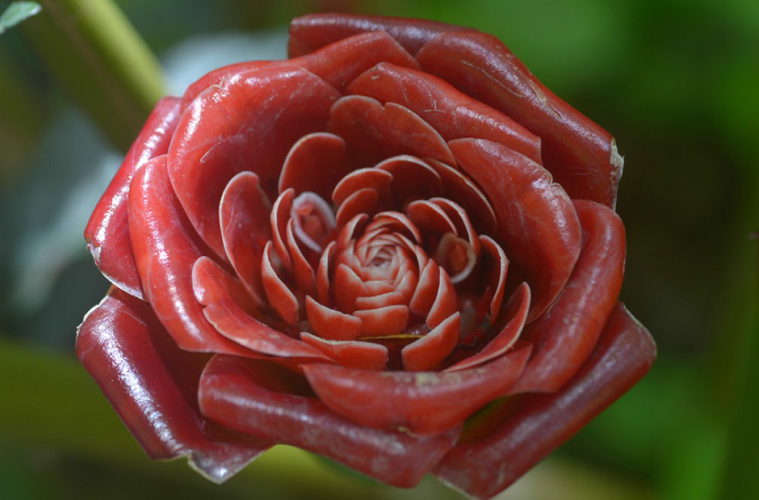Spring is the time when many gingers start flowering or emerge from underground dormancy. Many waxy, long-lasting flowers of Etlingera, the genus for the torch ginger, are starting to bloom in Waimea Valley’s “Torch Ginger Alley” in the farthest (from the main road) part of the large Ginger/ Heliconia collection between the 2nd and 3rd
bridges. The “Alley” is planted next to the one tributary stream, the Kaiwiko’ele that flows for about 200 yards from this spot before joining the main waterfall stream under the 2nd bridge.
The flowers of all torch gingers grow on a separate stalk from the tall, arching leaves. Twenty accessions, four wild-collected, have come to Waimea since 1975.The most well-known species is Etlingera elatior of which we have at least five forms. The beautiful pure white form is at the far end of the “Alley”. Halfway in are the common red and one that came as “Porcelain Pink” with uniform pink petals. Other pink torches in the Valley will make a ring of red flowers atop the pink head. One uncommon red torch has extremely narrow white edges to all the petals. Two less commonly grown torches are on both sides of the entrance: The “Malay Rose” is E. venusta with grey, pink, and white parts to its flower head, and opposite is the “Rose of Siam”, E. corneri, as it was officially named by former Pupukea resident and Waimea botanist, John Mood. John also discovered a new species in Borneo which he named E. rubromarginata with a low inflorescence uphill from the white torch. Closest to the stream is a large stand of the “Tulip Torch Ginger” E. hemisphaerica with tall side petals resembling a tulip as it’s growing before a mass of its small yellow-edged flowers splay out to make it become a very different looking inflorescence.
There are no native gingers in Hawai’i, however, the Polynesians brought two useful species which are planted all over the Valley. They’ve been completely underground for the last few months, but are now awakening with the spring rains and longer days. There’s only one genus of ginger in all of the Americas, yet the diversity in Asia is staggering and many have evolved to cope with the monsoonal rains that are common there. Before and after the
monsoons are long, dry periods, and the plants have learned to retreat to their underground rhizomes in a sort of hibernation before the rains come back. The two Asian gingers brought to Hawaii before contact are the ‘awapuhi and ‘olena. The first is the “shampoo ginger” (really used as a conditioner), Zingiber zerumbet, and the second is turmeric, the indispensable (and orange colored) part of any curry, Curcuma longa, which is also one of nature’s
best medicinal plants, an anti-inflammatory which fights infections.
Throughout the collection, Kaempferia and Curcuma species are appearing for their summer performance. For some species, like K. pulchra, the peacock lily, richly patterned leaves come up first. Many species of Curcuma send up their pink, yellow and green flowers before their leaves which all can be seen at the Ginger and Heliconia Garden.
We invite you to come and enjoy this botanical beauty, May and June are optimal months so bring the family for a stroll through our Torch Ginger Alley.
By David Orr, Botanical Collections Specialist, Waimea Valley on Oa`hu’s North Shore.



